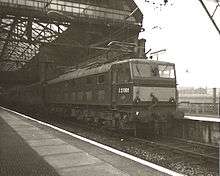British Rail Class 77
The British Rail Class 77, also known as Class EM2, is a class of 1.5 kV DC, Co-Co electric locomotive. They were built by Metropolitan-Vickers in 1953–1954 for use over the Woodhead Line between Manchester and Sheffield.
| British Rail Class 77 | |||||||||||||||||||||||||||||
|---|---|---|---|---|---|---|---|---|---|---|---|---|---|---|---|---|---|---|---|---|---|---|---|---|---|---|---|---|---|
Preserved locomotive no. 27000 in original black livery | |||||||||||||||||||||||||||||
| |||||||||||||||||||||||||||||
| |||||||||||||||||||||||||||||
| |||||||||||||||||||||||||||||
| |||||||||||||||||||||||||||||
Description
Seven locomotives of this type were constructed. They represented the first Co-Co type of overhead electric locomotive built for use in the United Kingdom. The design was based on that of the smaller Class EM1, which dated from 1941. Initially, 27 locomotives of this type had been planned, but by the early 1950s, the benefits of using the 25 kV AC system had been demonstrated, which meant that the Woodhead Line would be an isolated electric system. Consequently, the order was cut to just seven locomotives.

The locomotives were initially numbered 27000-27006 and were painted in BR black livery. Construction took place at Gorton Works, Manchester with electrical equipment supplied by Metropolitan-Vickers. All seven were named after characters from Greek mythology in 1959-1960. They were primarily used for express passenger trains between Manchester Piccadilly and Sheffield Victoria. In 1957, the class was renumbered with the addition of an "E" prefix to the number. In the early 1960s, the class started to receive the standard BR green livery. At least one of the class, E27002, received the electric blue livery carried by the AC electric locomotives.
The class was withdrawn en masse in September 1968. They were stored at Bury by BR in the hope of sale to a foreign railway. The passenger service for which the Class 77s were built continued to be operated by Class 76s, until its withdrawal on 5 January 1970. The Woodhead Line was closed as a through route in 1981, leaving just stubs between Manchester Piccadilly and Hadfield in the West and Sheffield Victoria and Deepcar in the East.
Forty more powerful class 46 electric locomotives were built by Metropolitan-Vickers in the mid-1950s for the New South Wales Government Railways.[1] The class 46 was based on the EM1 and EM2.
Further use
_at_Manchester_Museum_of_Science_and_Industry.jpg)
In September 1969 the entire class was sold to the Dutch national railway operator Nederlandse Spoorwegen, where they became NS 1500 Class. They were renumbered in the 1500 series in the order they left their workshops, where they received various modifications, including new headlight clusters. The locomotives also retained their names. One locomotive, no. E27005 Minerva was broken up and used for spares. The remaining six locomotives were employed until final withdrawal in 1985. Their main work was on The Hague—Cologne express trains as far as the border at Venlo although they travelled to their home depot at Maastricht either with a train or light engine on Sunday for their weekly examination before returning to traffic the following day. They were sometimes to be found on freight trains bound for the German border originating in the Rotterdam area.
Fleet details
| Key: | Preserved | Scrapped |
|---|
| BR number | NS number | Name | Disposal | |
|---|---|---|---|---|
| 1955 | 1957 | |||
| 27000 | E27000 | 1502 | Electra | Preserved at Midland Railway - Butterley |
| 27001 | E27001 | 1505 | Ariadne | Preserved at Manchester Museum of Science and Industry |
| 27002 | E27002 | 1506 | Aurora | Scrapped (02/1985) |
| 27003 | E27003 | 1501 | Diana | Preserved in the Netherlands by Werkgroep 1501 |
| 27004 | E27004 | 1503 | Juno | Scrapped (10/1986) |
| 27005 | E27005 | - | Minerva | Used for parts by NS. Scrapped (11/1969) |
| 27006 | E27006 | 1504 | Pandora | Scrapped (02/1985) |
References
- Singleton, C.C. (October 1956). "The 46-Class Electric Locomotive". Australian Railway Historical Society Bulletin: 142–144.
Further reading
- Hooper, John (2014). EM1 & EM2: An Illustrated Historical Review of the Manchester, Sheffield, Wath, Electric Locomotives - 76s & 77s. Book Law Publications. ISBN 9781909625198. OCLC 922549032.
- McManus, Michael. Ultimate Allocations, British Railways Locomotives 1948 - 1968. Wirral. Michael McManus.
- Ward, David (January 1986). "EM2 Twilight". Rail Enthusiast. No. 52. EMAP National Publications. pp. 30–31. ISSN 0262-561X. OCLC 49957965.
- "The Tommies Rock-On into History". Rail Enthusiast. No. 59. EMAP National Publications. August 1986. pp. 12–13. ISSN 0262-561X. OCLC 49957965.
- Ward, David (December 1986). "Homeward Bound". Rail Enthusiast. No. 63. EMAP National Publications. pp. 70–73. ISSN 0262-561X. OCLC 49957965.
- Ward, David (September 1988). "BR and NS EM2s on the move". RAIL. No. 84. EMAP National Publications. p. 17. ISSN 0953-4563. OCLC 49953699.
External links
| Wikimedia Commons has media related to Class 77. |